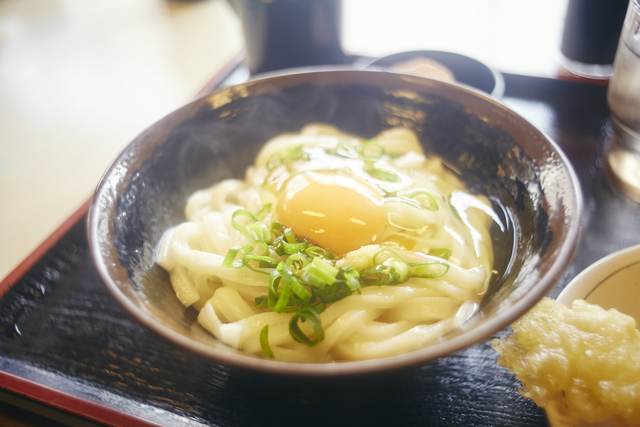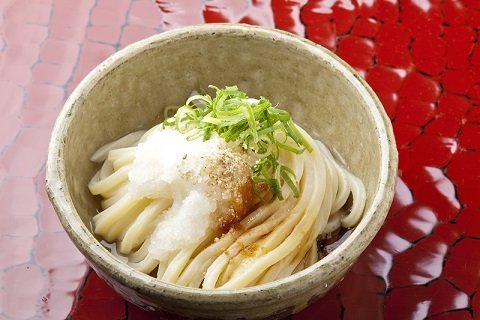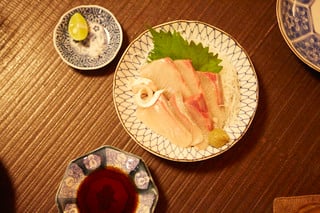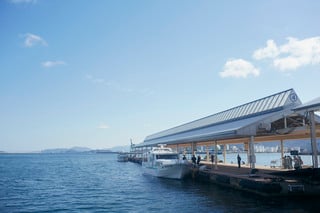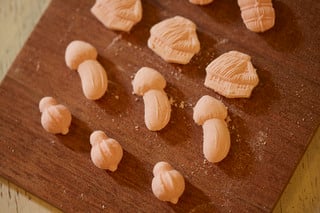The soul food of the local people in Kagawa is Sanuki udon. Popular Sanuki udon shops often have customers lined up to taste the most popular udon noodle in Japan. The thick white noodles have a silky texture and a distinct firmness, and are often complemented by a light brown soup with iriko (dried young sardines) broth. Sanuki udon boasts a wide variety of menu items and a range of serving styles in different types of eateries. Below, we present five tips to help you enjoy the local Kagawa specialty.
1. BEST RECOMMENDED MENUS
There are numerous unique styles of Sanuki udon including simple menus like hot kake-udon, cold zaru-udon, as well as noodles topped with curry and tempura. Each udon eatery has different menus and specialties – why not try the popular ones recommended by each shop?
【TYPICAL SANUKI UDON MENUS】
Kake-udon: hot udon noodles served in hot soup
via www.my-kagawa.jp
Zaru-udon: cold udon noodles served with dipping sauce
via www.my-kagawa.jp
Bukkake-udon: udon noodles served with a thicker, smaller amount of broth soup (hot/cold)
via www.my-kagawa.jp
Shoyu-udon: udon simply seasoned with soy sauce (hot/cold)
via www.my-kagawa.jp
Kamatama: steaming hot udon noodles topped with raw egg and soy sauce
via www.my-kagawa.jp
Udon with curry: udon noodles served with light flavored curry cooked in a soup broth
via www.my-kagawa.jp
2. CHOOSE HOT OR COLD FOR NOODLES AND SOUP
While you can choose your udon served hot or cold, some menus also offer a choice of serving temperatures for noodles and soup, respectively. For example, you can choose cold noodles with hot soup, hot noodles with hot soup, cold noodles with cold soup and so forth. Udon menus allow for a range of choices so that you can eat them however you prefer, depending on the season. It is nice to have cold udon in summer and hot udon during winter. Serving temperature options are often indicated on the menu.
3. CHOOSE THE SERVING AMOUNT
Once you have made your decision from the menu, choose your serving amount. “Small” is a single serving and is often called hito-tama (one serving of noodles) in Japanese. However, there is no standard amount for hito-tama and the actual amount often differs from one eatery to the next. Nonetheless, “small” is less food and often easily finished by women. “Medium” is one and a half servings and “large” is two-to-three servings. It may be better to choose “small” if you are planning to go to several restaurants.
4. FOLLOW THE ORDERING PROCEDURE IN SELF-SERVICE RESTAURANTS
At udon restaurants the staff generally comes to your table to take your order and the menu often helpfully includes photos of each item. In self-service eateries you need to be somewhat cautious when ordering, for the rules here are completely different. Upon entering such a restaurant, the first thing you need to do is to pick up a tray and decide which udon you want to order. You will then let the kitchen staff how you like your udon cooked and receive a bowl. Then select from side dishes on the counter, including freshly cooked tempura, rice balls and oden, and pay for them at a register. Fill your bowl with soup at a soup counter if it has not yet been served and add toppings like chopped green onions and deep-fried tempura batter. Finally, find your table and enjoy your udon! Be sure to bring the empty bowls back to the return window before you leave.
5. TRY ODEN, A PERFECT SIDE DISH TO GO WITH UDON
While many Japanese people think of winter when it comes to eating oden, this is not the case for people who live in Kagawa. Eaten as an appetizer, oden is a popular side dish available throughout the year at any udon restaurant in Kagawa. Typical oden ingredients include Japanese radish, konjac food, boiled egg and beefare all slowly cooked with udon broth soup. As for the oden dish, customers are often asked to help themselves pay for what they ate once they have finished their meal, even in udon restaurants with table-service.
Don’t leave Kagawa without tasting what may be the best udon in Japan!
27 records
 FIND SHIKOKU
FIND SHIKOKU




